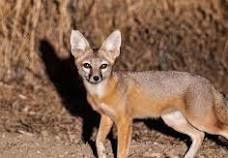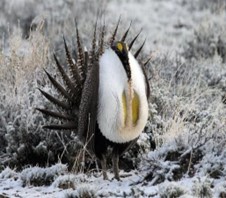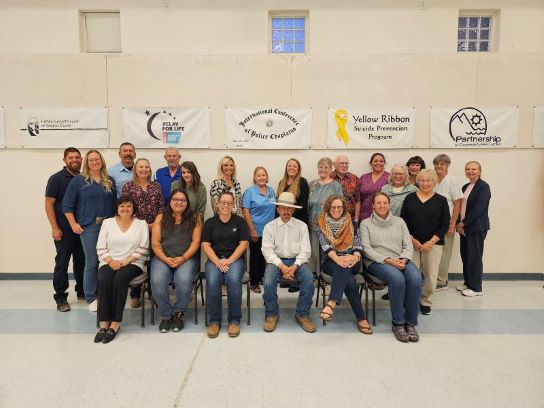In this edition
- Master Gardener Volunteer Program
- Wildlife in the Winter Garden
- Volunteers
About the Newsletter
The Master Gardener Volunteers of Douglas County provide horticulture education on gardens, landscapes, plants, pest control and other home horticulture-related topics. This newsletter of January 2024 is one of the many resources of information available to the public to help accomplish this mission.

Western Swallowtail Butterfly on Pink Phlox
Master Gardener Volunteer Program

Extension Master Gardener Logo
The Master Gardeners of Douglas County stands as a vital pillar in fostering a resilient and knowledgable community of gardeners.
Our program places a stong emphasis on research-based horticulture education, recognizing the unique challenges and opportunties presented by the Nevada climate. Through workshops and hands-on trainings, Master Gardener volunteers are able to provide the Douglas County community with the resources they need to be successful in their landscapes.
The fun and new workshops/events/hands-on trainings the Extension Master Gardeners of Douglas County will be sponsoring in 2024 are the following:
- Seed Swap - January 27, 2024
- Native Plant Sale - May 18, 2024
- Heritage Park Gardens Q&A Sessions - Wednesdays 5:30-6:30 pm, June - September 2024
- Plant Swap - End of summer
By intertwining education with community engagement, the University's Master Gardener program of Douglas County contributes not to the beauty of local landsacpes but also to the sustainability and well-being of hte entire community.
If you want to keep up to date on events/programming happening at Extension Douglas County, subscribe to our calendar.
Extension Douglas County Events Calendar
Wildlife in the Winter Garden
By: Ingrid Angelini
Contributing Authors: Annie Christy & Lorna Doerr
With snow and winter rain our gardens lose their lush, green appeal. Other elements of the natural world enter into focus, mainly members of the animal kingdom. These creatures can be entertaining or frustrating depending on where one lives.
The Carson Valley, with its abundance of water features, attracts a great many critters in the animal kingdom. Those residing in Douglas County include 32 species of the mammal class, 49 species of birds and 14 species of reptiles or amphibians. Not surprisingly, after birds, the second largest group is fish, with 24 species here. (Fish will not be included in this article but serve as a great food source for many of the creatures described herein.) The diversity of these animals and sheer number of species is due, primarily to the aquatic features present in the Carson Valley.
Included in the mammals are the white-tailed and black-tailed jack rabbits, desert cottontail, and pygmy rabbits, little brown, Mexican free-tailed, spotted and western long- eared bats. The aquatic species include the muskrat, beaver, river otter and mink. There are 3 canines: coyote, red fox, and kit fox and 2 felines: bobcat and mountain lion.
Small rodents include the desert kangaroo rat, dark kangaroo mouse and the pika, which resembles a young rabbit, due to its lack of an external tail. Also, present are 2 squirrels, one of which flies, and the other, a marmot, is a cat-sized ground squirrel, active in summer, often living in groups, and hibernating underground in winter. Mid-sized mammals are the badger, racoon, skunk and ringtail. Large creatures are the mule deer, pronghorn antelope, rocky mountain elk, and black bear. Also included in this group are the bighorn sheep and its subspecies, the desert bighorn sheep.
 kit fox
kit fox
The reptiles and amphibians category include the Columbia spotted and northern leopard frogs, the desert horned, great basin collared, long-nosed leopard, Shasta alligator, pygmy short-horned and zebra-tailed lizards, the great basin gopher, great basin rattle and rubber boa snakes, the western pond and spadefoot toads in addition to the western pond turtle.
Aquatic species of birds include the greater sandhill crane, the tundra swan, the canvasback, ring-necked, gadwall, mallard, pintail, shoveler, wood, scaup, wigeon and redhead ducks, green-winged teal (also a duck), the Canada, greater white-footed, snow and ross geese, the white pelican and the coot. Shore dwellers number 5 species: bank swallow, black tern, bittern, Wilson’s snipe and avocet. The owls are the spotted and western-burrowing species. Gamebirds number 3: Hungarian partridge, ring-necked pheasant and chukar. The 2 eagles are the golden and bald. Other raptors include the ferruginous hawk, northern goshawk, osprey, and peregrine falcon, as well as 1 nocturnal fowl: the common nighthawk. Also, here can be found 4 ground dwellers: California and mountain quail, killdeer plus the striking sage grouse.

Great Basin Sage Grouse
Its cousin, the sooty grouse, lives in the forest. Local scavengers are the crow and common raven. Then there are the rosy and Cassin’s finches, the Eurasian collared and mourning doves, pinyon jay, the wild turkey and thief: the magpie.
A great tool to help identify birds is the Merlin Bird app, which used photos, sounds and behavior/setting to find the answer. No one has all these 94 species visiting their property. It depends on where you live. If you have a pond, marsh or river on your property, your number of visitors will be far greater than folks without these features.
For obvious reasons, the majority of creatures are located at or near rivers, marshes and other aquatic sites. The edge of the forest, in the foothills, is second in line for popularity for many of these animals. Open areas, like farms, sagebrush country and similar valley floor locations attract other particular species.
Urban and suburban residents will likely see doves, and occasionally other small birds, such as the pinyon jay, and finches. If fruit trees are growing in the yard the fruit may be protected from their pecking by installing bird netting over the trees. It must be well secured beneath the canopy to prevent these feasters from approaching from below and subsequently becoming unable to escape when they attempt to fly away.
Other than these birds, the primary invader may be the neighborhood cat, who may attempt to use the vegetable and flower beds as a litter box, and in the process disrupt the soil or taint it to make the produce unhealthy. This can be prevented by placing wire screening over the planted area or trapping the animal. Other pets, likewise, should be kept out of the edible garden area.
Large open areas are used by rabbits, ground nesters, such as the badger and burrowing owl, as well as lizards and small birds. If agriculture or gardening is taking place here the only animals to fence out are rabbits. The small birds and lizards can be entertaining, and the raptors who prey on these species can keep the population in check. Badgers, who reside in groups, can be destructive, as a significant portion of their diet is derived from digging underground.
Foothill sites are host to rabbits, bats, lizards, jays, magpies, sage grouse, chukar and pika, as well as the raptors who prey on them. Quite a few of these creatures spill over to adjoining areas, such as wetlands, open areas described above and forested environments, which can protect the raptors.
As expected, wetlands provide food, breeding grounds and some shelter to minks, muskrats, otters, bats, smaller birds, the pelican, ducks, geese, the swan and the turtle. Muskrats are considered a pest by the state’s Department of Agriculture. Recommended damage control practices include exclusion, elimination of their food source, draining farm ponds in winter or killing with pesticides, traps or bullets. Be careful, however, using pesticides, as these may travel up the food chain when another creature devours the carcass. Otters are considered to be state protected, yet listed as fur-bearing game. The pelican is capable of damaging recently planted crops by trampling and depositing guano. Ducks will eat just about any garden pest, such as grasshoppers, beetles, grubs and even mice. They will also catch flies and root their larvae out of manure and decaying vegetables. The downside, however, is that they enjoy seedlings and may even snuggle down on a young plant, so be sure to protect these with a wire mesh. Geese, as well, enjoy tender, young plants, so do the same as for ducks.
While both these species may provide some protection against unwanted insects and other critters, their feces may contain pathogens that should not be consumed by humans.
Given the diet of our only turtle, this creature is neither beneficial nor undesirable in the garden. Rats and mice can gather in vegetation at the edges of fruit and vegetable patches, so it is best to keep these areas clear. Remove decaying fruits and vegetables in or adjacent to the garden, as it will attract these animals.
Anyone residing at high elevation may encounter the sooty grouse, which feeds upon leaves, buds, berries, conifer needles and insects. This ground bird may best be excluded from a garden with fencing. Also residing in this environment are the sheep, both of which prefer alpine meadows and mountain slopes. They cannot negotiate snowfall deeper than 5 feet, and often relocate to the foothills, near rocky cliffs. They compete with coyotes, bobcats and golden eagles for lambs, otherwise grazing on grasses and shrubs.
Some creatures dramatically overlap different ecozones. The black bear, for example, prefers a forested mountain environment but has been spotted at the Candy Dance in Genoa and at the Carson Valley Golf Course in Gardnerville. An omnivore, it feeds on human food, garbage, coyotes, mountain lions and humans. Mule deer move between various habitats, but seem to prefer arid, open areas and rocky hillsides. An unfenced lawn in an urban, suburban or remote area may be an invitation for deer to graze or take an afternoon rest in the shade. They are attracted by birdseed, pet food, trash, compost and fallen fruit. The great basin rattlesnake is widespread, existing from the lowlands to 11,000 feet of elevation. Its primary food source is rodents, so eliminating things that attract these critters will also deter the snakes.
In case you want to attract birds to your garden in winter, you may want to try using feeders, birdbaths, birdhouses or homemade suet cakes, which can be created using the following recipe. Melt 1 cup of shortening and 1 cup crunchy peanut butter in a saucepan over low heat. Add 2 cups rolled oats, 2 cups cornmeal, 1 cup flour and 1 cup sugar. Stir well to form a sticky mixture. Spoon into cookie cutters on waxed paper, no thicker than 1 inch. Poke a hole in each suet cake near the top, to thread a ribbon through. Freeze for a week. Remove from cookie cutter and peel off the waxed paper. Thread the ribbon through the hole and hang outside for the birds.
References:
- Following the Nevada Wildlife Trail, Dave Mathis
- Food Safety Tips for your Edible Home Garden, Western Institute for Food Safety and Security
- National Park Service
- Nevada Department of Agriculture Nevada Department of Wildlife
- Sharing the Knowledge, UC Tuolumne Master Gardeners US Department of Agriculture
Volunteer Appreciation Dinner 2023

Extension Douglas County Volutneer Appreciation Dinner Group photo 2023
November of 2023, the University of Nevada, Reno Extension Douglas County hosted its first Volutneer Appreciation dinner for the 4-H, Master Gardeners and Extension Volutneers. Without these volunteers, the University's Extension of Douglas County would not have such meaningful impact.
Thank you to all that volutneer and all that will in the future.
For more information on volunteering please contact our office: 775-782-9960
Master Gardener Program
Do you like to learn new things and share them with your community? Become a Master Gardener Volunteer in your community. Enrollment for classes opens in the Spring of 2024 and classes begin in August of 2024. For more information, please contact Jessica Gardner @ jessicagardner@unr.edu or 775-782-9960
We hope to see you in the garden!


